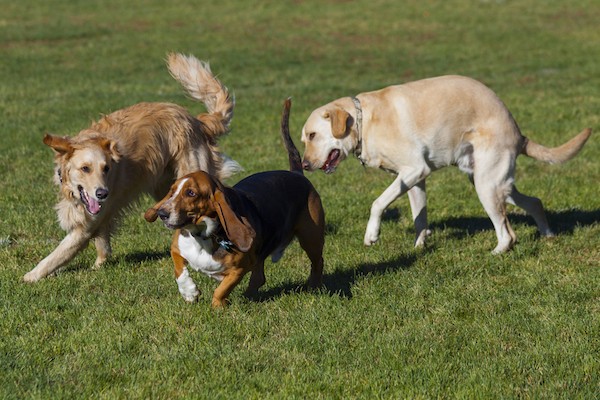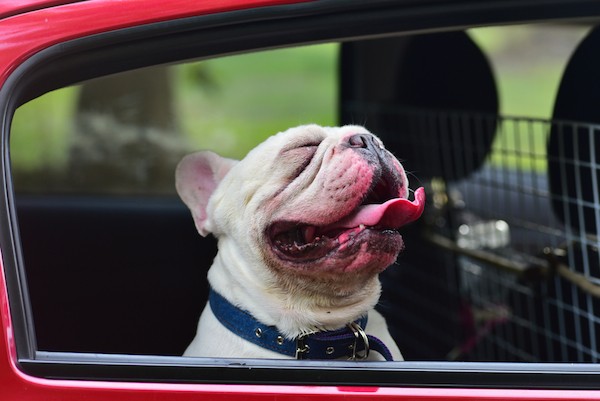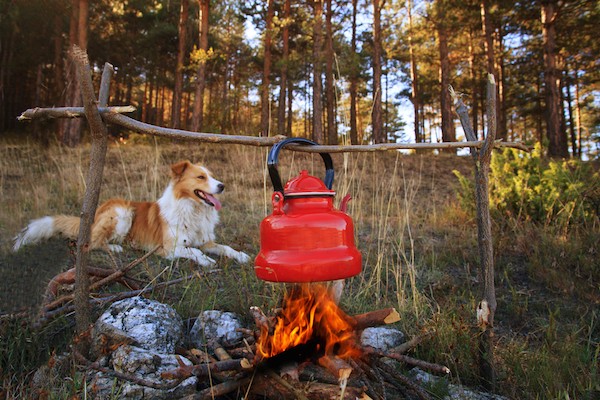I was born and raised on a small family farm/ranch in Southern Idaho, lived in a trailer court during veterinary school, moved to a subdivision during my first 17 years of practice, and have lived the past 19 years on a 150-acre horse ranch deep in the mountains of northern Idaho. So, I’ve lived and had dogs in a wide variety of outdoor situations, have treated hundreds of injured patients over my almost four decades of practice, and have personally had dogs injured.

Dr. Marty Becker via Dr. Marty’s Facebook page.
My goal in this article is to let you know of both obvious and hidden outdoor dangers and (hopefully) to prevent your dog from ever being a victim to something that is preventable.
I consulted with Dr. Tony Johnson, a veterinarian who’s one of the world’s top experts in emergency medicine and the chief medical officer for the Veterinary Information Network. Here are the top 10 outdoor dangers for dogs:
1. Heat
Far and away, heatstroke is enemy No. 1 in summertime! It’s deadly, expensive, and 100-percent avoidable if you take the right steps. Keep your dog indoors, and make sure he has shade and fresh, cool water if he goes outside. Dogs with snub noses (like Bulldogs and Pugs) do even worse in hot, humid weather, so keep it cool indoors. If your dog does overheat, douse him with water, blast the air conditioner, and get him to your vet straightaway!
2. Dog parks
On the surface, it’s hard to take issue with a dog park: It encourages dogs (and their owners) to go out and
get some exercise, fresh air, and sunshine, all the while strengthening the human-animal bond.
But in my vet ER career, I’ve seen a massive number of injured dogs coming to the emergency room directly
from a nearby dog park.
Not everyone has a well-trained and well-behaved dog, and you need to learn how to look out for the other guy and protect your dog from injury.

Dogs at the park by Shutterstock.
Here are a few simple rules to keep people and pets safe while still enjoying the dog park:
- Get to know your dog’s playmates. If you know the temperaments and dispositions of the dogs your dog plays with, you are much more likely to come away unscathed.
- Know the park’s layout. Are there any areas where dogs could interact and possibly fight? Are they out of your line of sight? If a fight happens, is there an easy exit?
- Keep watch. This might be the most important rule of all. Watch what your dog is doing and whom they’re doing it with. Be ready to swoop in and break up a fight if you have to. If you have a small dog who’s romping with a bigger dog, stay alert. Similarly, if you see a dog owner who’s not paying attention, that could be a recipe for disaster. Don’t just toss your dog in the park and wander off — you’re there to protect him from danger.
- Protect both yourself and your dog. If something happens, are you ready? A can of pepper spray, dousing with cold water, or using a big stick to pry a dog away from its victim can save a life. Be ready for things to go wrong, and be ready to act if they do.
3. Cars (inside them)
Your car can go from comfy to roasting in just minutes. Dogs can’t sweat to get rid of body heat. Instead,
they pant to try and dissipate the extra heat. But if they’re locked in a car with no ventilation, they only
make more heat by panting.
Just how long it takes for the car to heat up to a dangerous level depends on the weather and the size
of the dog, but it’s safe to say that in just a few minutes you can go from new-car smell to hot car hell.
The first way to prevent this is to leave your pet at home. In all the cases I’ve ever treated (and I’ve seen too many cases of this) the situation was totally preventable.
If you do see a dog left in a hot car, first try and find the owner and see if he or she will get the dog out. Calling for help from the police is also a good idea. As with heatstroke, the faster the dog is cooled off and the sooner he gets medical attention, the better his chances for recovery.

French Bulldog in a car by Shutterstock.
4. Cars (outside them)
They say good fences make good neighbors, but a good fence does much more. It can keep your dog safe from roaming. Trauma from being hit by a car is a major cause of canine injury and death, and an open gate is an invitation to trouble. Make sure gates don’t blow open during a storm and that guests and workers don’t leave them open when coming and going.
5. Thunderstorms
To help your dog make it through summer thunderstorms, try the following. (For severe cases, you might need sedatives from your veterinarian.)
- Bring your outside dog inside, or put him in your garage or basement during the storm (just make sure
there’s nothing toxic like antifreeze within his reach). - Use music, toys, or TV to distract him, and keep him in the quietest part of your home during storms. Some dogs stay calm when they’re in a pet crate or in a dark and quiet room. Toys (like a Kong-type toy filled with peanut butter) can be a great way to keep his mind off the noise.
- Get ID for your dog, such as a license, tag, or microchip, in case he gets scared and bolts out of the house. Dogs with identification have a greater chance of being reunited with their families.
6. Poison
Prevention is key for most poisons. Keep your own medications out of reach and in child-safe containers,
and always pick up dropped pills quickly. Never give your own medications to your dog or give one pet’s medication to another.
Some warm-weather poison risks to your dog include:
- Blue-green algae in ponds
- Compost bins
- Swimming pool or hot tub chemicals
- Venomous animals like toads, snakes, or scorpions

Pills via Shutterstock.
Here are some tips for a dog-safe home:
- Keep cleaning products and chemicals sealed and out of your dog’s reach.
- Keep garbage pails covered and away from your dog.
- Check under cabinets and behind the toilet for dropped pills.
- Clean up spilled antifreeze right away — as little as a teaspoon can kill.
- Keep your medications off of accessible places like the nightstand.
7. Food
One of the biggest warm-weather threats to your dog: food. Vomiting and diarrhea are common after eating “people food,” and they can also cause a more serious condition known as pancreatitis. Keep your dog confined during parties or outings, and tell your guests not to give any treats to your dog.
If vomiting or diarrhea happens, stop feeding, take up the food and water, and offer a little mixed fatfree cottage cheese and boiled white rice in a few hours. If the vomiting keeps up, your dog acts sick, or you see any blood in the diarrhea, it’s time for a trip to the vet.
8. Campfires
Dogs are permanent toddlers — always wondering things like, “Hey! What’s that smoky, burny thing over there?” And they can get into a whole heap of trouble before you know it — trouble that can lead to pain, injury, and big medical bills or even the loss of your home if a fire starts.
Here are a few fire safety tips to protect your pet and your home:
- Extinguish open flame. Pets are always curious and will investigate appliances, candles, or fireplaces. Remember: Toddlers grow up, but dogs and cats never do!
- Pet-proof your place. Walk around and look for trouble areas where pets could accidentally start a fire.
- Secure puppies and kittens. Keep young pets confined when you’re away from home by using a crate or secure room.
- Practice a fire escape with pets in mind. Keep leashes or a carrier ready in case you have to make a fast exit; right near the door is best.
- Use a pet alert window sticker. In case of a house fire, put this on a front window or door to alert firefighters that pets are inside.

Dog near campfire by Shutterstock.
I haven’t seen that many burn cases in my 20 years as an emergency vet, but one does stand out. I remember a little Dachshund, with the sadly appropriate name of Chili, who was camping with his family when he decided to jump into the ashes of a campfire — ashes that looked cool on the top but hid a layer of embers. He was burned in the blink of an eye and needed weeks of treatment.
9. Heartworm disease
Transmitted by mosquitoes, heartworm is a well-named disease: It’s a worm that lives in your dog’s heart.
It sounds like sci-fi, but it’s 100-percent real and 100-percent deadly. Luckily, you can prevent heartworms by keeping your dog on a heartworm preventive year-round.
Don’t get out of the habit of giving heartworm preventive in winter, even in areas with a hard frost. I’ve
seen many cases of dogs contracting heartworm in spring when their owners forgot to restart the preventive. Heartworm treatment is painful and expensive and doesn’t always work, so focus on prevention.
10. Boredom
Make time to play with your dog when the weather turns nicer, and let him accompany you on camping trips
and other excursions. A bored dog has the potential to be destructive in your house, so beat the summertime blues by keeping your dog and yourself active and engaged.
The post Keep Your Dog Safe From These 10 Outdoor Dangers appeared first on Dogster.
No comments:
Post a Comment